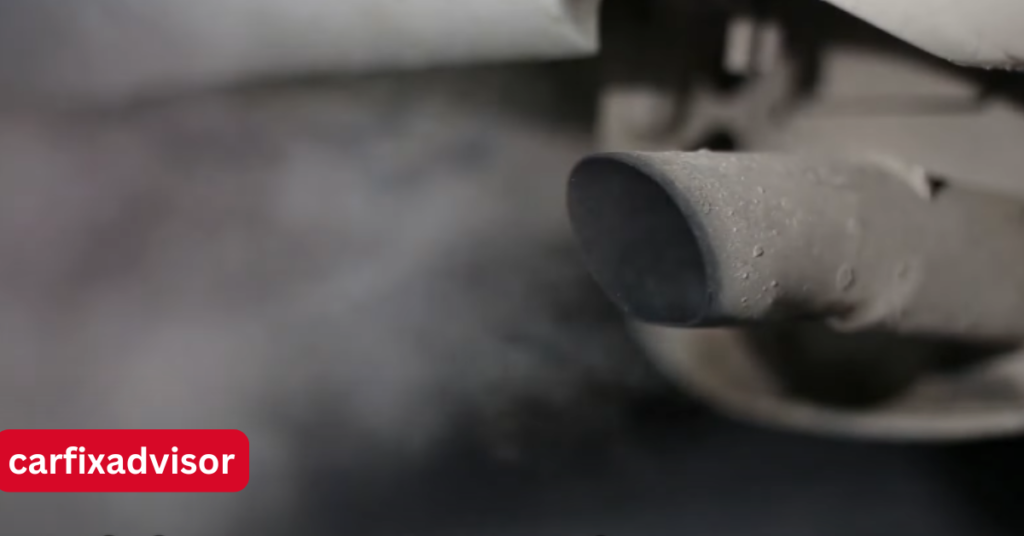Diesel engines are known for their durability and long lifespan, capable of running for millions of kilometers if maintained properly. Their simple yet sturdy construction and resilient internal components make them less likely to experience sudden failures. However, just like any other engine, diesel engines still require regular servicing to keep them running smoothly.
One of the first signs that something might be wrong with your diesel engine is the color of the exhaust smoke. Whether it’s black, white, blue, or grey, the color of the smoke can indicate specific issues with your engine’s performance. In this article, we’ll focus on grey smoke from Diesel Engine Blowing Grey Smoke When Accelerating, providing you with a comprehensive guide to diagnose the issue, understand potential causes, and find the right solutions.
What Does Diesel Engine Blowing Grey Smoke Mean?
Diesel Engine Blowing Grey Smoke is often a sign of abnormal combustion. Unlike black smoke, which generally points to an issue with fuel combustion, grey smoke typically indicates a problem with the engine burning oil. When you notice grey smoke coming from your diesel exhaust, especially when accelerating, it can be due to one of several possible reasons.
It’s important to differentiate between occasional grey smoke, which could be caused by temporary factors, and persistent grey smoke, which usually signals an underlying mechanical issue that needs attention.
Causes of Diesel Engine Blowing Grey Smoke :
Excessive Oil Consumption: The most common cause of Diesel Engine Blowing Grey Smoke burning too much oil. Diesel engines use oil to lubricate internal components, and a small amount of oil is typically burned during normal operation. However, if the engine starts burning an excessive amount of oil, it leads to the formation of grey smoke. This could be due to several issues, such as worn-out engine components or faulty seals.
Worn Valve Seals: The valve seals are responsible for preventing oil from entering the combustion chamber. Over time, these seals can wear out, allowing oil to leak into the combustion chamber, which leads to grey smoke during acceleration.
Worn Piston Rings: Piston rings help maintain compression within the engine’s cylinders. When these rings become worn or damaged, they fail to keep the oil properly contained, which can result in excessive oil burning and the production of grey smoke.
Failing Turbocharger Seals: A malfunctioning turbocharger can also cause grey smoke. The turbo seals are designed to prevent oil from leaking into the exhaust system. If these seals are worn or damaged, oil can leak into the exhaust, resulting in grey smoke when accelerating.
PCV Valve Issues: The Positive Crankcase Ventilation (PCV) valve is designed to allow excess gases from the engine’s crankcase to be recirculated back into the intake system. A sticky or faulty PCV valve can cause an imbalance in the pressure levels in the engine, leading to grey smoke as the engine burns more oil than it should.
Common Symptoms Diesel Engine Blowing Grey Smoke When Accelerating
When you notice grey smoke from the exhaust, it’s essential to pay attention to any other symptoms that may accompany the issue. These can provide additional clues about what’s wrong with your diesel engine.
Poor Acceleration: If you experience sluggish acceleration or the engine seems to be struggling to gain power, it could be related to the excessive oil consumption causing poor combustion efficiency.
Engine Misfire: A misfire is often accompanied by grey smoke, as the excess oil leads to incomplete combustion.
Low Engine Performance: An engine burning excessive oil can cause a drop in overall performance, affecting fuel efficiency, engine response, and power output.
How to Diagnose Grey Smoke From Diesel Exhaust
Diagnosing the cause of grey smoke from your diesel exhaust involves a series of tests and inspections. While some issues are relatively easy to spot, others may require professional expertise. Here’s how you can start diagnosing the problem:
Check Oil Levels: Start by checking your oil levels. If your oil level is low and you’re noticing grey smoke, it’s likely that the engine is burning more oil than normal. In this case, topping up the oil may temporarily reduce the smoke, but the underlying issue will still need to be addressed.
Inspect the Valve Seals: Worn valve seals are a common cause of grey smoke. If you suspect this is the problem, a professional mechanic will need to perform a compression test or inspect the seals directly to determine if they need replacement.
Perform a Compression Test: A compression test will help assess the health of the engine’s cylinders and piston rings. If the compression is low in one or more cylinders, it could indicate that the piston rings are worn or damaged, leading to excessive oil consumption and grey smoke.
Examine the Turbocharger: If you suspect that the turbocharger is the culprit, inspect the turbo seals for any signs of oil leakage. A professional mechanic can also perform a diagnostic test to determine if the turbocharger is functioning properly.
Inspect the PCV Valve: If the PCV valve is faulty or clogged, it can lead to abnormal pressure in the engine, causing oil to burn and resulting in grey smoke. A simple inspection or replacement of the PCV valve can resolve this issue.
Other Considerations
It’s important to remember that not all instances of grey smoke are due to severe engine problems. In some cases, the smoke could be caused by temporary issues, such as:
Cold Weather: Diesel engines in cold climates may produce a brief amount of grey smoke when first started. This usually clears up once the engine warms up. If the smoke persists, however, it’s time to investigate further.
Fuel Additives: Some diesel fuel additives can cause a temporary increase in exhaust smoke. This should be addressed by switching to a higher-quality fuel or discontinuing the use of additives.
Now that you have a better understanding of the potential causes and diagnostic steps for grey smoke from your diesel exhaust, let’s delve deeper into possible solutions, the importance of timely intervention, and the preventive measures you can take to avoid these issues in the future.
How to Fix Diesel Engine Blowing Grey Smoke
Once you’ve identified the cause of the grey smoke, the next step is to address the underlying issue. Here are the common solutions based on the diagnosis:
1. Replacing Worn Valve Seals
If your grey smoke is caused by worn valve seals, you’ll need to have them replaced. This is typically a job for a professional mechanic, as it involves disassembling parts of the engine to access the seals. Valve seal replacement can improve combustion efficiency by preventing oil from leaking into the cylinders and causing grey smoke.
2. Rebuilding or Replacing Piston Rings
When piston rings are worn or damaged, they fail to create a proper seal between the piston and cylinder walls. This leads to excessive oil consumption and the production of grey smoke. Rebuilding or replacing the piston rings is a complex procedure that requires professional expertise. If the rings are severely damaged, the engine may need to be disassembled, and the piston rings replaced.
3. Turbocharger Repair or Replacement
If the turbo seals are worn and causing oil leakage into the exhaust system, a turbocharger repair or replacement may be necessary. A professional mechanic can inspect the turbocharger and determine if the seals are the issue. In some cases, simply replacing the seals is enough, but if the turbocharger itself is damaged, it may need to be replaced entirely.
4. PCV Valve Replacement
A faulty Positive Crankcase Ventilation (PCV) valve can cause pressure imbalances within the engine, leading to excessive oil consumption and grey smoke. Replacing the PCV valve is a relatively simple and inexpensive fix that can prevent further damage and reduce grey smoke emissions. This is typically a quick job for a mechanic and should be performed at regular service intervals.
Preventive Measures to Avoid Grey Smoke in the Future
While diagnosing and fixing the issue is essential, the best way to deal with grey smoke is to prevent it from happening in the first place. Regular maintenance and timely intervention can keep your diesel engine in top shape and avoid the common causes of grey smoke.
Regular Oil Changes
Routine oil changes are essential for the health of your engine. Old, dirty oil can cause excessive wear on the engine components, including the valve seals, piston rings, and turbocharger. Changing the oil at regular intervals, according to the manufacturer’s recommendations, ensures that the engine is lubricated properly, reducing the risk of grey smoke.
Monitoring Oil Consumption
It’s important to keep an eye on your diesel engine’s oil consumption. If you notice that your oil levels are dropping rapidly or that you need to add oil more frequently, it’s a sign that something may be wrong. Early detection of oil consumption issues can help prevent the engine from burning excessive oil and producing grey smoke.
Use High-Quality Diesel Fuel
The quality of the fuel you use plays a significant role in engine performance. Low-quality fuel can cause poor combustion, which may lead to the production of grey smoke. Always opt for high-quality diesel fuel from reputable sources to ensure smooth engine operation and minimize the risk of issues like excessive oil consumption.
Keep Your Engine Clean
Regular engine cleaning can prevent the buildup of carbon and other debris that can impair the function of critical engine components. Cleaning the intake manifold, turbocharger, and exhaust system can help maintain optimal performance and prevent the issues that lead to grey smoke. An annual engine cleaning during your regular service check-up is a great way to keep things running smoothly.
Follow Manufacturer’s Maintenance Schedule
One of the best ways to avoid grey smoke and other engine problems is to follow the manufacturer’s recommended maintenance schedule. This includes regular checks and inspections of engine components, as well as replacing worn parts before they cause more significant issues. Regular maintenance helps you catch potential problems early, ensuring your engine runs at its best.
When to Seek Professional Help
While some minor issues can be addressed with simple solutions, grey smoke from a diesel engine often indicates a more significant problem that requires professional attention. If the smoke persists even after trying the basic diagnostic steps, or if you notice a significant drop in engine performance, it’s time to consult a qualified diesel mechanic.
A professional mechanic has the tools and expertise needed to diagnose and repair the complex issues that cause grey smoke, such as piston ring wear, turbocharger problems, or faulty valve seals. Ignoring persistent grey smoke can lead to further damage, reducing the lifespan of your engine and increasing the repair costs.
Conclusion: Understanding the Importance of Timely Action
Grey smoke from a diesel exhaust when accelerating is not something to ignore. While it can be caused by temporary factors, persistent grey smoke is usually a sign of an underlying engine problem that needs to be addressed as soon as possible. Identifying the cause early on and taking the appropriate steps to fix the issue can prevent costly repairs and ensure that your engine continues to perform at its best.
By regularly servicing your diesel engine, monitoring oil consumption, using high-quality fuel, and following the manufacturer’s maintenance schedule, you can keep your engine running smoothly and avoid the frustration and expense of grey smoke. If in doubt, always consult a professional diesel mechanic to ensure your engine is operating at peak efficiency


